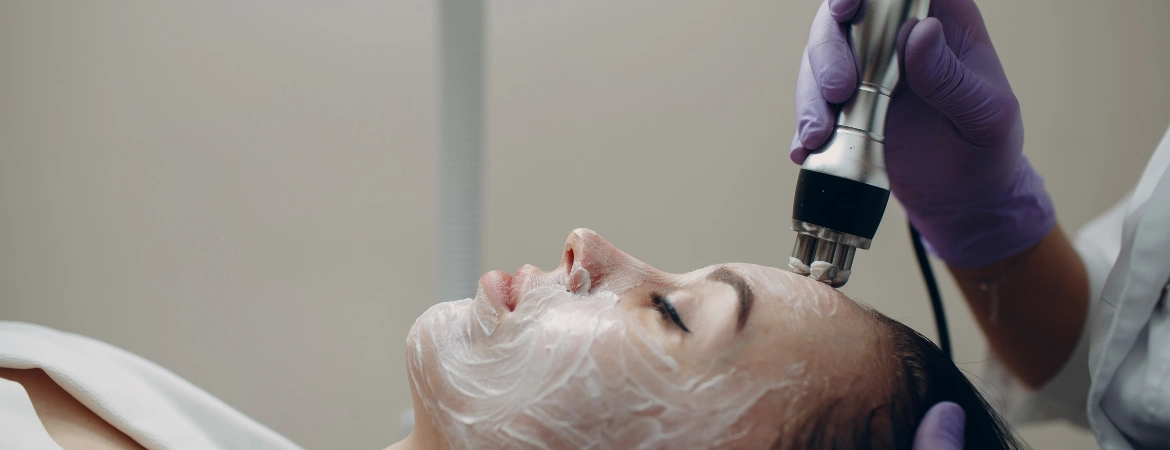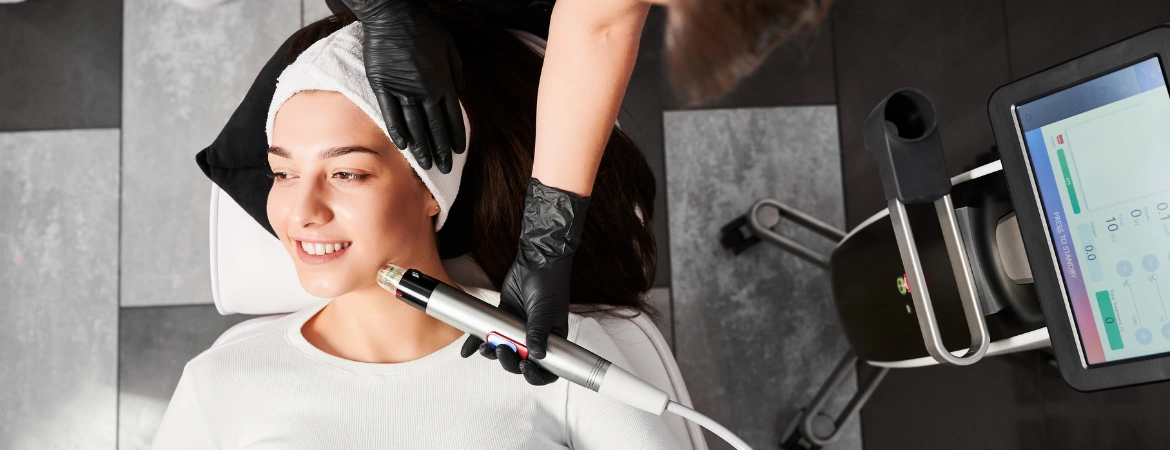
Welcome to the world of radiofrequency dermatology, where the secrets to achieving youthful and tight skin are revealed. If you’ve been longing for a non-surgical solution to rejuvenate your skin, then radiofrequency dermatology might just be the answer you’ve been searching for. With its remarkable ability to tighten the skin and promote a more youthful appearance, this innovative procedure has gained popularity around the world.
So, what exactly is radiofrequency dermatology? It’s a non-invasive treatment that utilizes radiofrequency energy to stimulate collagen production and improve skin texture. By harnessing the power of radiofrequency waves, this technique works wonders in tightening loose skin, reducing fine lines and wrinkles, and restoring a youthful glow.
Unlike other skin rejuvenation techniques, radiofrequency dermatology stands out for its effectiveness and long-lasting results. By delving deep into the layers of the skin, it targets the foundational tissues and triggers the production of collagen, which is essential for maintaining skin elasticity and firmness. The best part? The results of radiofrequency treatments are gradual and natural, leaving you with a refreshed and revitalized appearance without going under the knife.
If you are longing for youthful skin, the secrets of radiofrequency dermatology are waiting to be unveiled. Discover the benefits, explore the basics, and weigh the risks – all in one comprehensive guide. Get ready to embrace the world of radiofrequency dermatology and unlock the key to timeless beauty.
Table of Contents
ToggleExploring the Basics of Radiofrequency Dermatology
In the world of skincare, radiofrequency dermatology has gained significant popularity as a non-invasive treatment option for skin rejuvenation. But what exactly is radiofrequency dermatology, and how does it work? In this section, we will delve into the basics of this innovative procedure and explore its science, as well as compare it to other skin rejuvenation techniques.
What is Radiofrequency Dermatology?
Radiofrequency dermatology, also known as RF treatment, is a cutting-edge non-surgical procedure that utilizes radiofrequency energy to target specific layers of the skin. Unlike invasive surgical procedures, RF treatment is minimally invasive and requires no incisions, making it an attractive option for those seeking to improve their skin’s texture and firmness.
The primary goal of radiofrequency dermatology is to stimulate collagen production, a naturally occurring protein that provides structural support to the skin. Through the application of radiofrequency energy, the targeted heat stimulates the skin’s collagen fibers, leading to their contraction and subsequent remodeling. This process results in skin tightening and improved elasticity, leading to a more youthful and rejuvenated appearance.
The Science Behind Radiofrequency Skin Tightening
Radiofrequency skin tightening works on a simple principle: heating the skin’s deeper layers to stimulate collagen production and promote skin tightening. During the procedure, a specialized device delivers controlled radiofrequency energy to the targeted treatment area, carefully heating the underlying tissues. This controlled heating triggers collagen synthesis, leading to the contraction of collagen fibers and the subsequent remodeling process.
As collagen production increases, the skin gradually becomes firmer, tighter, and more youthful-looking. The great advantage of radiofrequency dermatology is that it specifically targets the deeper layers of the skin while leaving the outer layers intact, minimizing any potential damage or downtime.
Comparing RF Treatment to Other Skin Rejuvenation Techniques
When it comes to skin rejuvenation, there are various treatment options available. However, radiofrequency dermatology has gained prominence due to its effectiveness and safety profile in comparison to other techniques.
Compared to surgical procedures like facelifts, RF treatment offers a non-invasive alternative that requires little to no downtime. It is a less expensive option with minimal risks and fewer potential complications.
Another popular skin rejuvenation technique is laser therapy. While both laser and radiofrequency treatments stimulate collagen production, radiofrequency dermatology is typically considered safer and has a wider range of indications. RF treatment is suitable for all skin types and can be performed on various areas of the body, including the face, neck, abdomen, and thighs.
Moreover, radiofrequency treatment can be combined with other cosmetic procedures, such as microdermabrasion or chemical peels, for enhanced results. This versatility makes it a valuable option for individuals seeking comprehensive skin rejuvenation.Overall, radiofrequency dermatology stands out as an effective, safe, and versatile treatment for skin rejuvenation. Its unique ability to reach the deeper layers of the skin, stimulate collagen production, and promote skin tightening sets it apart from other techniques.
Benefits of Radiofrequency Treatments for Skin Health

Radiofrequency treatments offer numerous benefits for skin health, making them a popular choice for those seeking skin rejuvenation. These non-surgical procedures utilize radiofrequency energy to stimulate collagen production and improve skin texture, resulting in a more youthful appearance.
One of the key benefits of radiofrequency treatments is their ability to promote collagen production. Collagen is a protein that helps to maintain the structural integrity and elasticity of the skin. As we age, collagen production naturally declines, leading to skin sagging and wrinkles. Radiofrequency treatments help to reverse these effects by triggering the production of new collagen, resulting in firmer and tighter skin.
In addition to collagen production, radiofrequency treatments also improve skin texture. The heat generated by the radiofrequency energy encourages the turnover of skin cells, leading to smoother and more refined skin. This can help to reduce the appearance of acne scars, fine lines, and other imperfections, giving the skin a more even and youthful look.
Another advantage of radiofrequency treatments is their non-invasive nature. Unlike surgical procedures, radiofrequency treatments do not require incisions or downtime, making them a convenient option for individuals with busy lifestyles. The treatments are typically quick and well-tolerated, with minimal discomfort during and after the procedure.
Furthermore, radiofrequency treatments are suitable for all skin types. Unlike certain laser treatments that may be limited to certain skin tones, radiofrequency energy can safely and effectively be used on a wide range of skin types. This makes it a versatile choice for individuals with diverse skin concerns.
In summary, radiofrequency treatments offer numerous benefits for skin health. By promoting collagen production and improving skin texture, these procedures can help individuals achieve a firmer, smoother, and more youthful complexion. Additionally, their non-invasive nature and suitability for all skin types make them an attractive option for those seeking skin rejuvenation.
Risks and Side Effects Associated with Radiofrequency Procedures
While radiofrequency procedures are generally considered safe and effective, it is important to be aware of the potential risks and side effects associated with these treatments. By understanding these risks, patients can make informed decisions and ensure their safety throughout the process.
1. Skin Sensitivity: Some individuals may experience skin sensitivity after radiofrequency treatments. This can manifest as redness, swelling, or mild discomfort. These side effects are usually temporary and subside within a few hours or days.
2. Burns: In rare cases, radiofrequency procedures can cause burns on the skin. This is more likely to occur if the energy levels are set too high or the treatment is not performed properly. To minimize the risk of burns, it is essential to seek treatment from a qualified and experienced dermatologist.
3. Pigmentation Changes: Radiofrequency treatments have the potential to cause temporary changes in skin pigmentation. This may include darkening or lightening of the treated area. However, these changes are usually temporary and resolve over time.
4. Scarring: While rare, scarring is a possible complication of radiofrequency procedures. This is more likely to occur if the skin is not properly cared for after the treatment or if the patient has a history of hypertrophic scars or keloids. Following post-treatment instructions and informing the dermatologist about any existing skin conditions can help minimize the risk of scarring.
5. Nerve Damage: In rare cases, radiofrequency treatments can cause nerve damage. This can lead to temporary or permanent numbness, tingling, or loss of sensation in the treated area. To reduce the risk of nerve damage, it is crucial to choose a qualified practitioner who has experience and expertise in performing radiofrequency procedures.
Before undergoing a radiofrequency procedure, it is important to have a thorough consultation with a dermatologist. During this consultation, the dermatologist will evaluate your skin type, medical history, and any potential risks or contraindications. They will also provide detailed post-treatment instructions to help minimize the likelihood of side effects and complications.
While the risks associated with radiofrequency procedures are generally minimal, it is important to be aware of them and take necessary precautions. By choosing a reputable practitioner and following proper aftercare instructions, patients can achieve the desired results while ensuring their safety and well-being.
Combining Radiofrequency Treatments with Other Cosmetic Procedures

Radiofrequency treatments have gained popularity in the field of cosmetic dermatology due to their ability to address various skin concerns and provide noticeable results. While radiofrequency treatments can be effective on their own, combining them with other cosmetic procedures can lead to enhanced and more comprehensive results.
Complementary cosmetic procedures can work in synergy with radiofrequency treatments to target different aspects of skin rejuvenation. By incorporating combination therapies, patients can experience more significant improvements in skin texture, firmness, and overall appearance.
One of the key benefits of combining radiofrequency treatments with other procedures is the ability to stimulate multiple pathways of collagen production. Radiofrequency stimulates collagen production by heating the deep layers of the skin, while other procedures such as microneedling or laser treatments enhance collagen synthesis through controlled injury or thermal energy.
The combination of radiofrequency treatments with other cosmetic procedures also allows for the customized treatment of multiple skin concerns. For example, combining radiofrequency with injectable dermal fillers can address both skin laxity and volume loss, resulting in a more youthful and rejuvenated appearance.
In addition to improved results, combining radiofrequency treatments with other cosmetic procedures can provide a cost-effective approach for patients. By utilizing combination therapies, individuals can achieve their desired outcomes without the need for multiple separate treatments.
However, it is essential to consult with a qualified dermatologist or cosmetic surgeon to determine the most suitable combination therapies for individual skin concerns and goals. A customized treatment plan can be developed based on factors such as skin type, specific concerns, and desired results.
In conclusion, combining radiofrequency treatments with complementary cosmetic procedures offers a comprehensive approach to skin rejuvenation. By utilizing combination therapies, individuals can achieve enhanced results and target multiple skin concerns simultaneously. Consultation with a qualified professional is crucial to ensure the most appropriate and effective combination treatments are chosen.
Advantages of Radiofrequency Dermatology in Turkey
Turkey has emerged as a popular destination for radiofrequency dermatology procedures, offering numerous advantages for patients seeking quality care and affordable options. Medical tourism in Turkey has been booming, with many individuals from around the world opting to undergo RF treatments in this country.
One of the key advantages of radiofrequency dermatology in Turkey is the high quality of care provided. Turkish medical facilities are known for their state-of-the-art equipment and experienced healthcare professionals. Patients can rest assured that they will receive top-notch treatment and personalized care throughout their RF procedures.
Moreover, Turkey offers a wide range of radiofrequency dermatology options to cater to different needs. Whether it’s skin tightening, wrinkle reduction, or overall skin rejuvenation, patients can find suitable RF procedures in Turkey. The variety of available options allows individuals to choose the most appropriate treatment plan for their specific concerns.
Another advantage of undergoing radiofrequency dermatology in Turkey is the affordability factor. Compared to many other countries, the cost of RF treatments in Turkey is relatively lower, making it an attractive option for those seeking cost-effective solutions for their skin concerns. This affordability, combined with the quality of care and advanced technologies, makes Turkey an ideal destination for RF treatments.
Furthermore, opting for radiofrequency dermatology in Turkey allows patients to turn their treatment into a well-rounded medical tourism experience. The country’s rich history, vibrant culture, and stunning landscapes make Turkey an enticing destination for individuals who want to combine their cosmetic procedures with an enjoyable getaway.
In conclusion, the advantages of radiofrequency dermatology in Turkey are evident. With its high quality of care, affordable options, and opportunities for medical tourism, Turkey has proven to be a leading destination for RF procedures. Patients can benefit from both the effective results of radiofrequency dermatology and the memorable experiences that Turkey has to offer.
Exploring the Basics of Radiofrequency Dermatology

Radiofrequency dermatology is a revolutionary non-surgical procedure that harnesses the power of radiofrequency energy to rejuvenate and tighten your skin. This innovative technique stimulates collagen production, resulting in improved skin texture and a more youthful appearance.
What is Radiofrequency Dermatology?
Radiofrequency dermatology is a cosmetic procedure that utilizes targeted radiofrequency energy to heat the deeper layers of your skin. By doing so, it triggers the production of collagen and elastin, essential proteins that help maintain your skin’s firmness and elasticity. The controlled heat energy delivered during the treatment promotes cellular turnover and stimulates the body’s natural rejuvenation process, resulting in tighter, smoother, and more youthful-looking skin.
The Science Behind Radiofrequency Skin Tightening
The science behind radiofrequency skin tightening lies in the ability of radiofrequency waves to safely heat the underlying layers of your skin. This controlled heating prompts the denaturation of existing collagen fibers and stimulates the production of new collagen. As the collagen fibers contract and regenerate, it leads to skin tightening and improved skin texture. Over time, the increased collagen production continues to enhance the firmness and elasticity of your skin, providing long-lasting results.
Benefits of Radiofrequency Treatments for Skin Health
Radiofrequency treatments offer numerous benefits for skin health, making them a popular choice for those seeking effective skin rejuvenation. Here are some key advantages of radiofrequency treatments:
- Collagen stimulation: Radiofrequency energy penetrates deep into the skin, stimulating collagen production. This helps to improve skin elasticity, firmness, and overall texture.
- Reduced wrinkles and fine lines: By promoting collagen synthesis, radiofrequency treatments can minimize the appearance of wrinkles and fine lines, giving your skin a smoother and more youthful look.
- Skin tightening: One of the main benefits of radiofrequency treatments is their ability to tighten sagging skin. The energy heats the underlying layers, causing the collagen fibers to contract and tighten, resulting in firmer, more toned skin.
- Minimal downtime: Unlike invasive procedures, radiofrequency treatments have minimal downtime. You can typically resume your daily activities immediately after the session, making it a convenient option for those with busy lifestyles.
- Improvement in skin texture: Radiofrequency treatments can improve the overall texture and smoothness of your skin. It can address various skin concerns, including acne scars, enlarged pores, and uneven skin tone.
- Long-lasting results: With proper maintenance and follow-up treatments, the results of radiofrequency treatments can be long-lasting. The collagen stimulation continues even after the sessions, ensuring ongoing skin rejuvenation.
These benefits highlight why radiofrequency treatments are a popular choice for individuals looking to enhance their skin health and achieve a more youthful appearance. Consult with a qualified dermatologist to determine if radiofrequency treatments are suitable for your specific skin concerns.
Advantages of Radiofrequency Dermatology in Turkey
Radiofrequency dermatology is gaining popularity as a non-surgical approach to skin rejuvenation, and Turkey has emerged as a preferred destination for these treatments. There are several advantages to consider when opting for radiofrequency dermatology in Turkey.
Firstly, Turkey is renowned for its high-quality medical care. The country boasts state-of-the-art facilities like Acibadem Ankara Hospital, and highly skilled dermatologists who specialize in radiofrequency treatments. Patients can feel confident in the expertise and professionalism of Turkish healthcare providers.
Additionally, radiofrequency dermatology in Turkey offers affordable options compared to other countries. The cost of procedures, such as radiofrequency skin tightening, is remarkably competitive, making it an attractive choice for individuals seeking effective yet cost-effective cosmetic solutions.
Furthermore, Turkey has become a popular medical tourism destination, with patients from various countries seeking radiofrequency dermatology treatments. This thriving medical tourism industry ensures that patients receive personalized care and have access to comprehensive services, including transportation and accommodation assistance.
In conclusion, the advantages of radiofrequency dermatology in Turkey are evident. By choosing Turkey for these procedures, patients can benefit from world-class medical facilities, affordability, and the convenience of medical tourism services. It’s no wonder that Turkey is becoming a preferred destination for those seeking the secrets of skin rejuvenation through radiofrequency dermatology.



